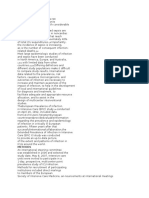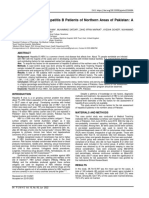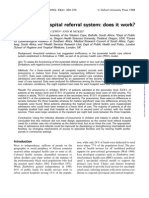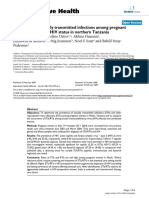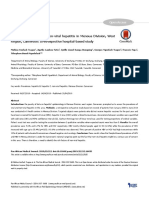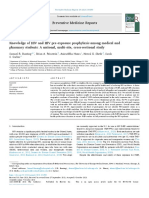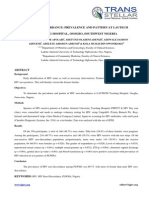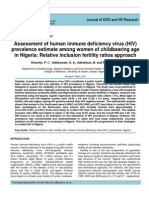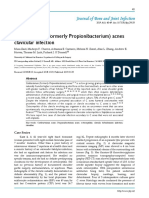2209 4526 1 SM
2209 4526 1 SM
Uploaded by
baloziandersonCopyright:
Available Formats
2209 4526 1 SM
2209 4526 1 SM
Uploaded by
baloziandersonOriginal Title
Copyright
Available Formats
Share this document
Did you find this document useful?
Is this content inappropriate?
Copyright:
Available Formats
2209 4526 1 SM
2209 4526 1 SM
Uploaded by
baloziandersonCopyright:
Available Formats
206 From Communicable to Noncommunicable Diseases and Injuries
Summary/Conclusion: While laypersons and hospital personnel Structure/Method/Design: We collected data on patients seen by
may receive and feel comfortable administering basic resuscitation HIV specialists on outreach to nine hospitals in southern Botswana.
techniques, further data must be collected to see if this intervention At each site, specialists saw outpatients referred by local general
improves mortality. Analysis of the newly implemented trauma reg- practitioners. Data collected from each encounter included HIV sta-
istry will evaluate mortality. tus and the reason for the encounter. Statistical analysis included
descriptive analyses and c2 test for categorical variables.
Results (Scientific Abstract)/Collaborative Partners (Program-
Esophageal cancer in Northern Tanzania: Geographical matic Abstract): Between March 2011 and February 2012, outreach
distribution and case characteristics physicians recorded 400 outpatient encounters. 56% (224/400) of
O.M. Munishi; Kilimanjaro Christian Medical Center, Community encounters occurred at primary hospitals and 44% (176/400) at
medicine, Moshi/TZ district general hospitals.
The majority (69%) of patients seen by specialists presented with
Structure/Method/Design: This was a descriptive retrospective two or more medical problems. The most frequent medical problems
study of histologically confirmed cases of esophageal cancer diagnosed encountered included hypertension, (17.5%, n ¼ 70), diabetes mel-
at the Kilimanjaro Christian Medical Centre, and identified through litus (8%, n ¼ 32), and congestive cardiac failure (5%, n ¼ 19).
its Cancer Registry and/or endoscopy unity, from 1998 to 2008. Cardiovascular diseases accounted for 29% of all diagnoses, neuro-
Demographic data (age, sex, village) were obtained from hospital re- logical diseases 15%, and endocrine diseases 12%. There was no
cords and a risk-factor questionnaire was administered to patient’s difference in either the spectrum of disease or the complexity of
relatives. medical problems seen at district versus primary hospitals.
Results (Scientific Abstract)/Collaborative Partners (Program- 27% of encounters were with patients with confirmed HIV
matic Abstract): 802 patients were diagnosed with esophageal cancer infection, the remainder had either unknown HIV status (32%, n ¼
during the study period, the majority of which was squamous cell car- 129) or were HIV-uninfected (40.3%, n ¼ 161). Among individuals
cinoma. 59% of cases were male. Mean age at diagnosis was 60 years with confirmed HIV-infection, 41% (n ¼ 41) of consultations related
(inter-quartile range 50-70). The age-standardized incidence rates (ASR to HIV management. The other most frequently encountered di-
to world population per 100,000) were 6.8 and 3.8 in men and women agnoses among HIV-infected individuals included hypertension
respectively. Large geographical variations were observed. ASRs were (10%), tuberculosis (7%), diabetes (5%), and meningitis (5%).
over 9 in men in Moshi Urban, Moshi Rural, and Hai and less than 3 in Summary/Conclusion: Over a 12-month period, physicians in
Rombo, Mwanga and Same districts. 96% of male cases and 92% of BUP’s outreach program saw a significant number of patients with
female cases had drank alcohol regularly; 38% and 5% had consumed NCDs at nine Botswana outreach facilities. Most patients were not
strong illicit moonshine spirits (gongo). Amongst drinkers, drinking HIV-infected and the most frequent conditions seen by physicians
started at mean age of 13 years, with 25% having started by age 8 and were hypertension, diabetes, and congestive cardiac failure.
mean lifetime years of drinking was 50 (SD 15.6). 87% of male and 36% This study is limited by referral bias. Nevertheless, the analysis
of female cases had smoked tobacco regularly. demonstrates how PEPFAR funding ensured access to physician con-
Summary/Conclusion: Within the high esophageal cancer area of sultations for NCDs as well as HIV. The data also supports growing
the Kilimanjaro region, the south and western districts adjacent to the evidence that Botswana faces a double-burden of infectious and non-
Kilimanjaro mountain peak have over 3-fold higher incidence rates infectious diseases. Given this epidemiologic transition, leveraging
than other districts in the region. Prevalence of alcohol and tobacco PEPFAR funded HIV-programing to expand access to care for patients
consumption is higher among cases than in previous population with NCDs is increasingly important. While long-term follow up is
surveys. These findings need further investigation in a broader necessary to assess the impact of PEPFAR on NCD services in Botswana,
analytical study. there is also an urgent need to build NCD capacity across the country.
Leveraging PEPFAR-funded HIV programming to Double-dipping: When your research answers
enhance to delivery of NCD care in southern Botswana unintended questions
M.J.A. Reid1, M. Haas2, M. Haverkamp1, P. Sedigeng1, W. Moloi3, A. Unger1, M. Reis2, A.I. Ko3; 1University of California San Francisco,
D. Ramogola-Masire1, H. Friedman2, A. Ho-Foster1; 1University of Medicine, San Francisco, CA/US, 2Oswaldo Cruz Foundation/Yale
Pennsylvania, Botswana-UPenn Partnership, Gaborone/BW, 2University School of Public Health, Salvador/BR, 3Yale School of Public Health,
of Pennsylvania, Botswana-UPenn Partnership, Philadelphia, PA/US, Epidemiolgy of Microbial Diseases, New Haven, CT/US
3
University of Botswana, School of Medicine, Department of Medicine,
Background: Global health research invests tremendous human
Gaborone/BW
and material resources into resource-poor settings. The scientific
Background: Botswana’s HIV prevalence is 19%, with antiretroviral model and the nature of IRB approval demand specific research hy-
drugs available to all eligible citizens. Through the President’s potheses, measured and carefully applied methods, and protection of
Emergency Plan for AIDS Relief (PEPFAR), the Botswana-UPenn participatnts and their health information. However, frequently the
Partnership (BUP) has provided HIV support to rural hospitals study of specific diseases leads to the collection of information that
across the country since 2006. Since the program’s inception, BUP’s may be relevant to other health problems. The investment to study
outreach has extended support to outpatient care for non- disease in often marginalized or hard-to-reach populations is sub-
communicable diseases (NCDs) to both HIV-infected and HIV-un- stantial, and the potential to use data collected, and resources created,
infected adults. Little data exists on how PEPFAR programming in for other purposes is an important consideration.
Africa impacts on the care for NCDs. We sought to describe the Structure/Method/Design: Our team has developed a community-
burden of disease referred to HIV specialists on outreach to hospitals based research project in 2003 in a large urban slum of 14,000
in southern Botswana. residents, called Pau da Lima, on the periphery of Salvador, the
You might also like
- Ophth 760 CasesDocument16 pagesOphth 760 CasesVarun100% (1)
- (Formerly Known As Max Bupa Health Insurance Co. LTD.) : Product Name: Reassure - Product Uin: Nbhhlip23107V022223Document64 pages(Formerly Known As Max Bupa Health Insurance Co. LTD.) : Product Name: Reassure - Product Uin: Nbhhlip23107V022223shivadigi3No ratings yet
- Botswana Ref Ranges PaperDocument7 pagesBotswana Ref Ranges PaperMunyaradzi MangwendezaNo ratings yet
- Fredrick Alleni Mfinanga and Tafuteni Nicholaus Chusi and Agnes B. ChaweneDocument6 pagesFredrick Alleni Mfinanga and Tafuteni Nicholaus Chusi and Agnes B. ChaweneinventionjournalsNo ratings yet
- 192302-Article Text-487545-1-10-20200117 PDFDocument9 pages192302-Article Text-487545-1-10-20200117 PDFnuurul nimahNo ratings yet
- Ijh2020 7965146Document9 pagesIjh2020 7965146jeri45No ratings yet
- 1 s2.0 S2173511517301550 MainDocument6 pages1 s2.0 S2173511517301550 MainHermenegildo chitumbaNo ratings yet
- 113_Bibush AmatyaDocument2 pages113_Bibush Amatyabibush.amatyaNo ratings yet
- Effectiveness of Outreach Clinical Mentoring On Retention in Care and Viral Suppression Among HIV Positive Young Persons On Art in North Central NigeriaDocument8 pagesEffectiveness of Outreach Clinical Mentoring On Retention in Care and Viral Suppression Among HIV Positive Young Persons On Art in North Central NigeriaInternational Journal of Innovative Science and Research TechnologyNo ratings yet
- (Pro) Ing 1, Ada Kuesioner Juga12Document8 pages(Pro) Ing 1, Ada Kuesioner Juga12ilhamNo ratings yet
- Abad - Assignment No. 2Document2 pagesAbad - Assignment No. 2Lester AbadNo ratings yet
- Revealed That: Among New and Among Re-Treatment TB Cases Had MDR-TBDocument32 pagesRevealed That: Among New and Among Re-Treatment TB Cases Had MDR-TBComingSoonNo ratings yet
- Knowledge, Attitudes, and Practices Among Physicians On HIV/AIDS in Quang Ninh, VietnamDocument13 pagesKnowledge, Attitudes, and Practices Among Physicians On HIV/AIDS in Quang Ninh, VietnamAli143MarymNo ratings yet
- Knowledge On HIV/AIDS Among Students of The Faculty of Health Sciences, Brazzaville, Republic of CongoDocument14 pagesKnowledge On HIV/AIDS Among Students of The Faculty of Health Sciences, Brazzaville, Republic of CongoNovita HerlitadewiNo ratings yet
- Factors Impacting Antiretroviral Therapy Adherence Among Human Immunodeficiency Virus-Positive Adolescents in Sub-Saharan AfricaDocument12 pagesFactors Impacting Antiretroviral Therapy Adherence Among Human Immunodeficiency Virus-Positive Adolescents in Sub-Saharan AfricaDouglas ChukwuNo ratings yet
- Ambo UniversityDocument12 pagesAmbo UniversityArarsa TolasaNo ratings yet
- Attitudes, Beliefs and Predictors of Male Circumcision Promotion Among Medical University Students in A Traditionally Non-Circumcising RegionDocument14 pagesAttitudes, Beliefs and Predictors of Male Circumcision Promotion Among Medical University Students in A Traditionally Non-Circumcising RegionVulka AzurNo ratings yet
- Early Detection of Tuberculosis Through Community-Based Active Case Finding in CambodiaDocument11 pagesEarly Detection of Tuberculosis Through Community-Based Active Case Finding in CambodiaPatriciann13No ratings yet
- Articulo 6 - OkDocument10 pagesArticulo 6 - OkLinda Elisa Gutierrez FloresNo ratings yet
- Burden of Prehypertension Among Adults in Kenya: A Retrospective Analysis of Findings From The Healthy Heart Africa (HHA) ProgrammeDocument6 pagesBurden of Prehypertension Among Adults in Kenya: A Retrospective Analysis of Findings From The Healthy Heart Africa (HHA) Programmeh3493061No ratings yet
- Undiagnosed Tuberculosis in Patients With HIV Infection Who Present With Severe Anaemia at A District HospitalDocument6 pagesUndiagnosed Tuberculosis in Patients With HIV Infection Who Present With Severe Anaemia at A District HospitalDian EsthyNo ratings yet
- Sonderup 2019Document8 pagesSonderup 2019cristian vivasNo ratings yet
- Infection Is Acommonproblem ForDocument11 pagesInfection Is Acommonproblem ForDitaMayasariNo ratings yet
- International Journal of Africa Nursing Sciences: SciencedirectDocument8 pagesInternational Journal of Africa Nursing Sciences: Sciencedirectmunira ulfa munaNo ratings yet
- Article1379671073 - Olugbenga-Bello Et AlDocument8 pagesArticle1379671073 - Olugbenga-Bello Et AlAmalia RiaNo ratings yet
- HSV TransmissionDocument21 pagesHSV Transmissionaulia.shafirarahmaNo ratings yet
- Risk Assessment of Hepatitis B Patients of Northern Areas of Pakistan: A Case Control StudyDocument3 pagesRisk Assessment of Hepatitis B Patients of Northern Areas of Pakistan: A Case Control StudyDr Alamzeb JadoonNo ratings yet
- Zimbabwe's Hospital Referral System: Does It Work? Zimbabwe's Hospital Referral System: Does It Work?Document12 pagesZimbabwe's Hospital Referral System: Does It Work? Zimbabwe's Hospital Referral System: Does It Work?Hiten DabhiNo ratings yet
- Research On Prevalence of TB FinalDocument9 pagesResearch On Prevalence of TB FinalBontuNo ratings yet
- 1742 4755 6 4 PDFDocument8 pages1742 4755 6 4 PDFAbdirahmanNo ratings yet
- Voluntary HIV Testing and Risky Sexual Behaviours Among Health Care Workers: A Survey in Rural and Urban Burkina FasoDocument7 pagesVoluntary HIV Testing and Risky Sexual Behaviours Among Health Care Workers: A Survey in Rural and Urban Burkina FasoadeekaNo ratings yet
- Abstract 59Document3 pagesAbstract 59Jarvis WheelerNo ratings yet
- Molecular Diagnosis of TB in The HIV Positive PopulationDocument10 pagesMolecular Diagnosis of TB in The HIV Positive PopulationajengzahraaaNo ratings yet
- ResearchDocument11 pagesResearchdon yenNo ratings yet
- BMC Research Notes: Research Article Open AccessDocument10 pagesBMC Research Notes: Research Article Open Accessseptia mutiaraNo ratings yet
- Challenges in The Recognition Management AKIDocument9 pagesChallenges in The Recognition Management AKISoniamartilovaNo ratings yet
- Ten-Year Experiences of The Tuberculosis Control Programme in The Southern Region of EthiopiaDocument6 pagesTen-Year Experiences of The Tuberculosis Control Programme in The Southern Region of EthiopiaDanielNo ratings yet
- Adherence To Antiretroviral Therapy and The Associated Factors Among People Living With HIV/AIDS in Northern Peru: A Cross Sectional StudyDocument12 pagesAdherence To Antiretroviral Therapy and The Associated Factors Among People Living With HIV/AIDS in Northern Peru: A Cross Sectional StudyALEX AARÓN COLLAZOS FLORESNo ratings yet
- CDC Epi Aid ReportDocument59 pagesCDC Epi Aid ReportAlvaro MejiaNo ratings yet
- HIV in Pregnancy-1Document42 pagesHIV in Pregnancy-1abdulrazakiddrisu1No ratings yet
- 1 Line Treatment Outcomes of The New Pulmonary Bacteriologically Confirmed TB Cases (2012 Cohort, %)Document34 pages1 Line Treatment Outcomes of The New Pulmonary Bacteriologically Confirmed TB Cases (2012 Cohort, %)ComingSoonNo ratings yet
- Sample PresentationDocument36 pagesSample Presentationmuhammed essaNo ratings yet
- HERO Results From The HERO Study - Treatment-Related Characteristics of The PopulationDocument14 pagesHERO Results From The HERO Study - Treatment-Related Characteristics of The PopulationLaboriusNo ratings yet
- Ini JGDocument9 pagesIni JGTessa Audy JaniarNo ratings yet
- A Kap Study of Hepatitis Among Hepatitis Positive Patients Presenting To A Tertiary Care Hospital in Southern Punjab, PakistanDocument4 pagesA Kap Study of Hepatitis Among Hepatitis Positive Patients Presenting To A Tertiary Care Hospital in Southern Punjab, Pakistanارسلان علیNo ratings yet
- Qual Paper 1 Palliative CareDocument11 pagesQual Paper 1 Palliative CareJamesNo ratings yet
- 1540-1413-Article-P496-Estudio Telemedicina CancerDocument14 pages1540-1413-Article-P496-Estudio Telemedicina CancerManuel WongNo ratings yet
- Haber 2017Document8 pagesHaber 2017Gisela M SilvaNo ratings yet
- The Role of a Pharmacist in the Analysis of Adherence Rates and Associated Factors in HIV-Patients Registered on Centralized Chronic Medicines Dispensing and Distribution (CCMDD) Programme in the Public Sector in South AfricaDocument11 pagesThe Role of a Pharmacist in the Analysis of Adherence Rates and Associated Factors in HIV-Patients Registered on Centralized Chronic Medicines Dispensing and Distribution (CCMDD) Programme in the Public Sector in South AfricaSabrina JonesNo ratings yet
- Preventive Medicine Reports: Samuel R. Bunting, Brian A. Feinstein, Aniruddha Hazra, Neeral K. Sheth, Sarah S. GarberDocument9 pagesPreventive Medicine Reports: Samuel R. Bunting, Brian A. Feinstein, Aniruddha Hazra, Neeral K. Sheth, Sarah S. GarberKnowledge PepalaNo ratings yet
- Hepatocellular Carcinoma Induced by Viruses Epidemiological Clinical and Therapeutic Aspects in Pointe Noire (Congo Brazzaville)Document6 pagesHepatocellular Carcinoma Induced by Viruses Epidemiological Clinical and Therapeutic Aspects in Pointe Noire (Congo Brazzaville)Scivision PublishersNo ratings yet
- Tropical Med Int Health - 2008 - Deribe - Defaulters From Antiretroviral Treatment in Jimma University Specialized HospitalDocument6 pagesTropical Med Int Health - 2008 - Deribe - Defaulters From Antiretroviral Treatment in Jimma University Specialized HospitalAbi UmmiNo ratings yet
- Effect of SMS Reminders On Loss To Follow Up Rates Among Type 2 Diabetics in An Urban Primary Care SettingDocument6 pagesEffect of SMS Reminders On Loss To Follow Up Rates Among Type 2 Diabetics in An Urban Primary Care SettingInternational Organization of Scientific Research (IOSR)No ratings yet
- Guerchet 2012 RCA RC EDACDocument6 pagesGuerchet 2012 RCA RC EDACkouame2907No ratings yet
- Medicine - Ijmps - Hiv Sero Discordance - Kola Musliudin OwonikokoDocument10 pagesMedicine - Ijmps - Hiv Sero Discordance - Kola Musliudin OwonikokoTJPRC PublicationsNo ratings yet
- 75-Article Text-329-1-10-20220929Document16 pages75-Article Text-329-1-10-20220929BrianNo ratings yet
- 1 s2.0 S2214139123000203 MainDocument9 pages1 s2.0 S2214139123000203 MainAziza AzizaNo ratings yet
- Ade Et AlDocument7 pagesAde Et Alkang.asep008No ratings yet
- 1 s2.0 S2214139123001166 MainDocument8 pages1 s2.0 S2214139123001166 MainM. PurnomoNo ratings yet
- Current Landscape of Patients With Metastatic Cancers in The PhilippinesDocument10 pagesCurrent Landscape of Patients With Metastatic Cancers in The Philippines052591No ratings yet
- AidsDocument8 pagesAidsmitasariiiNo ratings yet
- Life Histories of Genetic Disease: Patterns and Prevention in Postwar Medical GeneticsFrom EverandLife Histories of Genetic Disease: Patterns and Prevention in Postwar Medical GeneticsNo ratings yet
- Module 4 HiracDocument22 pagesModule 4 HiracGerald Hernandez100% (1)
- CV DR AkpathakDocument3 pagesCV DR AkpathakArupkumar PathakNo ratings yet
- Unit 1 CCNDocument154 pagesUnit 1 CCNImad khanNo ratings yet
- Fallon Coulombe Resume Lac Updated3-4Document2 pagesFallon Coulombe Resume Lac Updated3-4api-501819203No ratings yet
- Companies ExportDocument20 pagesCompanies ExporthiteshguptaNo ratings yet
- Drug Price Policy in VietnamDocument14 pagesDrug Price Policy in VietnamSteven NguyenNo ratings yet
- Flotanol 2040 - MSDSDocument7 pagesFlotanol 2040 - MSDSChama kapambweNo ratings yet
- Head InjuryDocument47 pagesHead InjuryRio Taruna JatiNo ratings yet
- Article 6Document7 pagesArticle 6WiktoriaNo ratings yet
- Network Hospitals List East RegionDocument16 pagesNetwork Hospitals List East RegionFohimuddin AhmedNo ratings yet
- SdasasasDocument22 pagesSdasasasGianne Robert MalavegaNo ratings yet
- Questions Nclex PMHNDocument11 pagesQuestions Nclex PMHNAhmad Isa AzzaNo ratings yet
- interdepartemental consultation 2016Document19 pagesinterdepartemental consultation 2016Megersa AleneNo ratings yet
- Research Article - Burnout Among Nurses in A Nigerian General HospitalDocument7 pagesResearch Article - Burnout Among Nurses in A Nigerian General HospitalAndrei AlexandruNo ratings yet
- Generic DrugsDocument9 pagesGeneric DrugsZanila YoshiokaNo ratings yet
- Appropriate Use of Laxatives in The Older PersonDocument7 pagesAppropriate Use of Laxatives in The Older PersonStacey WoodsNo ratings yet
- Alternative Medicine Conversation Class Conversation Topics Dialogs Oneonone Activities Pi - 79830Document3 pagesAlternative Medicine Conversation Class Conversation Topics Dialogs Oneonone Activities Pi - 79830Ludmila VintilovaNo ratings yet
- Dr. Shelly Iskandar, SpAkp, SPKJ, M.Si, PHD Webinar PDSKJI Yogya-PfizerDocument55 pagesDr. Shelly Iskandar, SpAkp, SPKJ, M.Si, PHD Webinar PDSKJI Yogya-PfizerKorn IbraNo ratings yet
- Gco Form 1personal Data RecordDocument5 pagesGco Form 1personal Data RecordROMELYN BALBIDONo ratings yet
- Hemorrhoids Pain Nursing PlanDocument6 pagesHemorrhoids Pain Nursing Planodoy_82No ratings yet
- LOADSTAR SHIPPING v. ERNESTO YAMSONDocument1 pageLOADSTAR SHIPPING v. ERNESTO YAMSONLara CacalNo ratings yet
- Cuti Bacterium 2019 Aid2019Document10 pagesCuti Bacterium 2019 Aid2019Vita BūdvytėNo ratings yet
- Physical Therapists & PT Assistants: Heidi Fries, PT, DPTDocument16 pagesPhysical Therapists & PT Assistants: Heidi Fries, PT, DPTamy_stainbrookNo ratings yet
- Hanadi CVDocument4 pagesHanadi CVapi-267142767No ratings yet
- Addressing Emotionally Based School AvoidanceDocument9 pagesAddressing Emotionally Based School AvoidancePolina Themistokleous100% (1)
- Functions of SDRRMT MembersDocument2 pagesFunctions of SDRRMT MembersSYLVIA R. DECOLONGONNo ratings yet
- Physical Fitness Assessment (Pfa)Document70 pagesPhysical Fitness Assessment (Pfa)bjh1965No ratings yet
- Annotated Bibliography Full WebsiteDocument11 pagesAnnotated Bibliography Full Websiteapi-548305272No ratings yet






















